“The budget is not just a collection of numbers, but an expression of our values and aspirations.”
This quote by U.S. Treasury Secretary Jacob Lew is an important starting point when we think about the state budget. Like a family that acts out its values when deciding how much to spend on things like saving for retirement, investing in education and activities for children, or paying for basic needs like food, shelter, and health care, the state of Oklahoma expresses our values through the budget for core public services like education, public health and safety, and infrastructure. The budget is how we allocate resources across not just state and local government agencies, but many private businesses and non-profits that receive public funds to do such things as build roads, operate nursing homes, or provide child care.
Like a family that sets its aspirations by going to work to increase the family income, Oklahoma’s decisions to raise taxes and other revenues decide what we have to invest in the building blocks of a prosperous state. The taxes that each of us pay represent our investment in shared prosperity.
Because we depend on government to support the common good and because we share in paying for the costs of government, many of us expect to influence its decisions. We can do that through elections, but their effect is limited. If we want to improve government services or the way we pay for them, we need to take more specific actions. And we cannot do that without a clear understanding of where we are and how we got here.
That’s where Together Oklahoma’s #betterok Budget Bootcamp comes in. To kick off the six week bootcamp, here’s an overview of key facts and data about Oklahoma’s state budget and tax system.
#1: Oklahoma’s Constitution puts strict limits on state taxes and spending
Unlike the federal government which can run a budget deficit, the state of Oklahoma is required to balance its budget every year. That means if revenue aren’t coming in to fund public services at the same level, lawmakers are required to cut spending or find new sources of revenue to make it balance.
Since Oklahoma voters approved State Question 640 in 1992, lawmakers have also been severely limited in their ability to increase any tax. SQ 640 requires any “revenue bill” to win a 3/4ths majority vote of both chambers or the legislature or a vote of the people in a general election.
#2: Oklahoma is a low tax state
In 2013 Oklahomans paid 24 percent less per person in state and local taxes than the national average. Of every $100 in income, Oklahomans paid $8.32 in state and local taxes (U.S. average: $10.35). Oklahomans’ taxes as a share of personal income are 47th lowest in the nation. Oklahoma collects less per person than the national average from all revenue sources except sales taxes and federal funds, where are above the average.
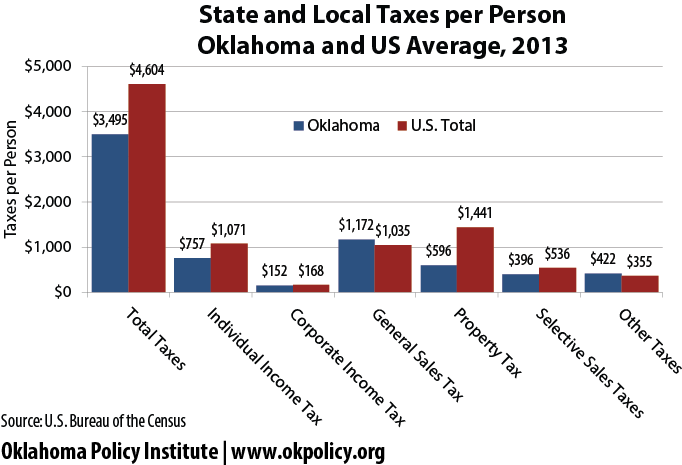
#3: Oklahomans’ state and local taxes have been on a consistent downward trend for 20 years
The figure below shows that while Oklahoma tax levels have been consistently below national averages since at least 1984, in the last two decades the gap has widened substantially. In 1998, Oklahoma taxes were just 26 cents below the national average for each $100 of income; by 2012 the gap had grown to $1.58 per $100 of income. According to data from the Tax Policy Center, Oklahoma ranked 47th among the states in 2013 by this measure. Among Oklahoma’s seven neighboring states, none ranked lower than Oklahoma in total state and local taxes per person.
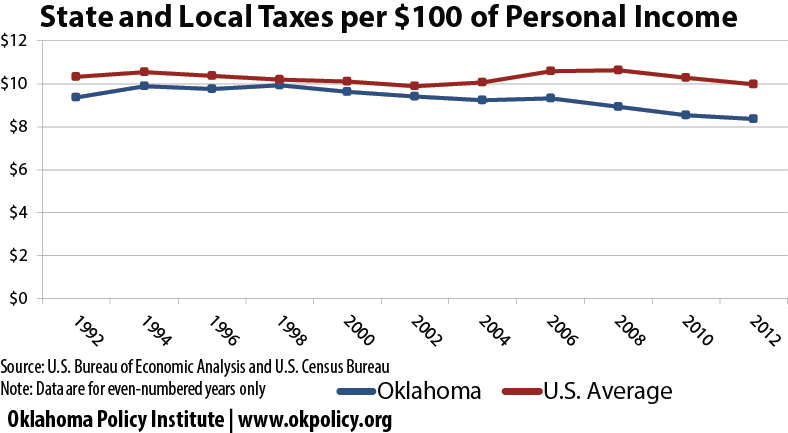
#4: Oklahoma invests much less than the national average on nearly all of our public services
Oklahoma state and local governments spend much less than the national average for all government services except transportation. Combined annual state and local government spending in Oklahoma is $8,373 per person, which is 17.2 percent below the national average of $10,116. Oklahoma ranked 46th in the nation in total state and local spending per person in 2013, according to the Urban Institute-Brookings Institution Tax Policy Center. Our per-person spending that year was 8 percent less than the average of our surrounding states.
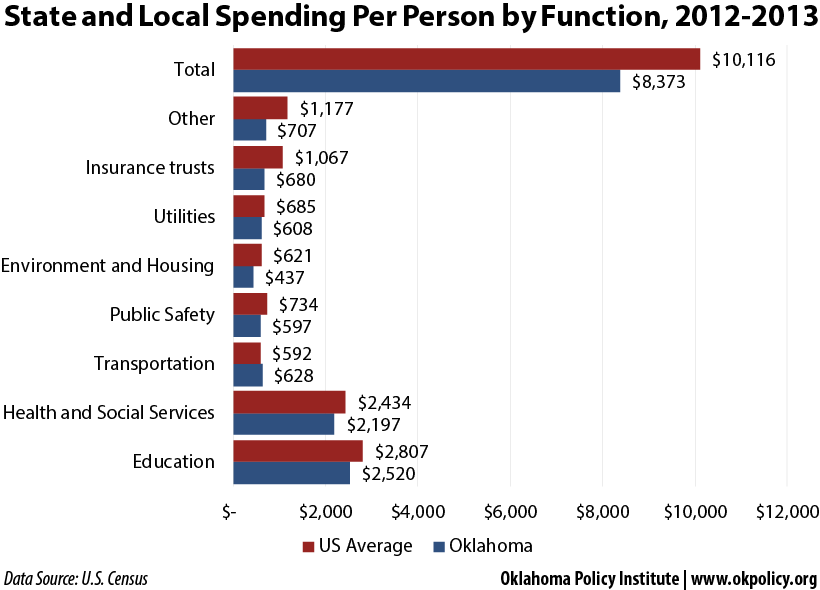
#5: The main sources of funding for government operations are state appropriations, federal funds, and dedicated funds
Appropriations are the most important funding source in government because our elected officials have the greatest discretion over how to use them. However, appropriations make up only about 30 percent of the state’s total spending. Federal and dedicated funds usually are not appropriated because their use is restricted for specific purposes. In some agencies, nearly all the funding comes from appropriations while, in many others, appropriations make up less than half the total spending of the agency. Some agencies receive no appropriations at all; they are funded entirely by federal and dedicated funds.
#6: More than 90 percent of state appropriations goes to 10 key agencies
While the state has nearly 70 agencies that receive appropriated funds, the overwhelming share of appropriated dollars go to only a few of the largest agencies that provide for education, health, human service, public safety and transportation. The ten largest agencies receive 90.6 percent of all appropriations in FY 2017, while the other 57 appropriated agencies receive 9.4 percent. The two largest agencies, Common Education (State Department of Education) and the Oklahoma Health Care Authority (Medicaid), receive over half the appropriations.
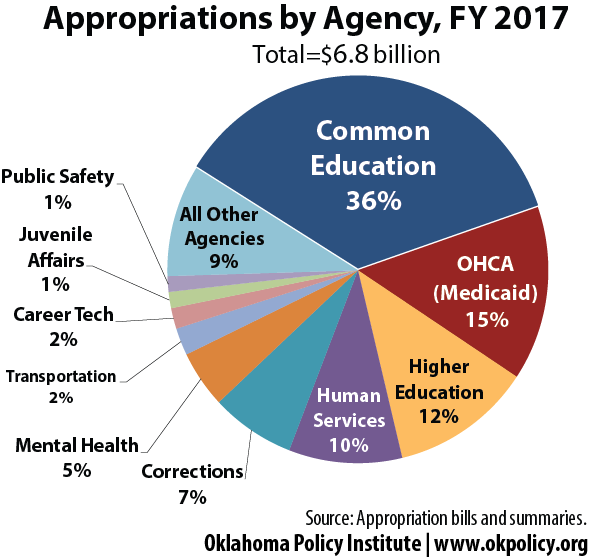
#7: State appropriations have been cut repeatedly over the past decade
Oklahoma made deep cuts to state appropriations during the Great Recession, and state funding has never returned to pre-recession levels. Since 2015, the downturn in the energy sector, combined with further cuts to the top income tax rate and the continued cost of tax breaks, has led to two consecutive years of large budget shortfalls and cuts. Budget cuts would have again been even deeper but for the use of money from the Rainy Day Fund and the use of various revenue enhancements, most of which amounted to one-time funds, rather than recurring revenues.
The initial appropriation for FY 2017 is nearly identical that of ten years ago. Due to inflation and population growth, this budget funds considerably less service than it did ten years ago. Adjusted for inflation, the FY 2017 budget is almost 15 percent less than the budget for FY 2007, for a total decline of $1.17 billion.

#8: Oklahoma is facing another large budget hole this year
A budget hole means Oklahoma lawmakers are expected to have less money to appropriate for the coming year than they do in the current year. The budget hole is caused by declines in revenue from Oklahoma’s major taxes as well as the use of one-time revenue in past budgets that is no longer available for next year’s budget. Lawmakers used over $600 million in one-time revenue to balance Oklahoma’s budget last year, which included issuing bonds to fund transportation, transferring money out of dozens of funds, and tapping the Rainy Day Fund.
Based on current estimates (which may change as the year progresses), lawmakers will have $740 million less to appropriate in next year’s budget than they used for this year.

The bottom line
The budget situation facing Oklahoma lawmakers this year will be enormously challenging. Budget shortfalls are a result of both economic factors and poor policy choices — but that means better policy choices can do a lot to fix the problem.
Over the next few weeks, you’ll learn more about the budget needs of Oklahoma’s core services like education, public safety, human services, and other areas. You’ll also learn about policy solutions to find the recurring revenues necessary to bring our budget into balance without more damaging cuts.
We hope this information empowers you to be the most effective advocate for a better budget and a #betterOK!






